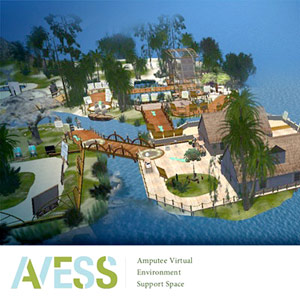Virtual worlds are computer-based environments-oftentimes hosted on the Internet and represented by graphics on a screen-that have become wildly popular tools for bringing real people together. Flesh and blood humans adopt “avatars,” graphical representations of themselves that may or may not look anything like the real deal, to interact with the virtual environment and other avatars. The most popular virtual world, Second Life, recently reported having 68,000 current users, and more than 15 million separate individuals have signed on since its 2003 inception.

Image courtesy of Business Wire.
Now, the Telemedicine and Advanced Technology Research Center (TATRC) of the U.S. Army Medical Research and Materiel Command (USAMRMC) has funded a project to build a virtual world for military service members who have amputations and for those amputees’ families. ADL Company, Bloomington, Maine; and Virtual Ability (VAI), Denver, Colorado, are the funding recipients and have begun a project to establish best practices and protocols for providing peer-support services for military amputees via an online universe. Linden Lab, San Francisco, California, owner of Second Life, has provided the test platform for what will become Amputee Virtual Environment Support Space (AVESS), a stand-alone virtual world with specially tailored features and security measures.
“For individuals with disabilities, virtual worlds are a powerful way to connect with others, to access peer support and to participate in activities that might not otherwise be possible,” said Alice Krueger, VAI president. “This project will establish the best way to adopt this technology for the unique needs of the military amputee community.”
Doug Thompson, a spokesperson for ADL, commented, “We have successfully used virtual-world technology in a number of areas, including as part of a long-standing project with the U.S. government Joint Medical Executive Skills Institute, through which we provide leadership training to healthcare professionals in the Tri Services…. This project will further extend the use and understanding of virtual worlds and establish global best practices. VAI is an invaluable partner on this project:. They have shown through example and experience how powerful virtual worlds can be in their ability to support people with all kinds of disabilities-physical, mental, emotional, and sensory.”
According to TATRC, recent U.S. military casualty figures for Operation Iraqi Freedom and Operation Enduring Freedom indicate that between September 2001 and mid-January 2009, more than 1,000 amputation injuries occurred, with 935 amputations considered major and many wounded warriors having lost more than one limb. While the rehabilitation goal is sometimes for the soldier to return to active duty, many reintegrate into their civilian communities. In either case, military amputations are often accompanied by additional wounds, depression, fear, phantom-limb pain, and post-traumatic stress disorder (PTSD).
Spouses and family members often become the caregivers of military amputees after they are released from military hospitals and rehabilitation programs. Family support members have their own grieving process to go through related to the amputation and to the change to family life. Peer-support groups help recent amputees gain experience and confidence and to practice the skills necessary to proceed with their rehabilitation. Support groups can also assist family members and spouses with their caregiving issues and concerns.
Krueger stressed, “Individuals come into virtual environments as a way to connect with others who have disabilities…. What they discover is that you don’t just find a community, you find a place where you can express yourself and feel like you have a shared space. It’s powerful. Virtual worlds offer an immediacy and a sense of presence that a website can’t offer. Amputees have been shown to respond positively to viewing themselves as an avatar in a three-dimensional environment.” According to TATRC, Krueger’s team has previously developed an award-winning support environment in Second Life for individuals with disabilities.
TATRC Program Manager, Ashley Fisher, said, “Our mandate is to explore new technology and how it can support service personnel. This is an exciting project for TATRC because it will let us define what we see as a potentially effective way to provide another form of support to military amputees.”




